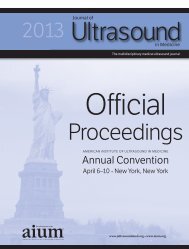Sonohysterography - AIUM
Sonohysterography - AIUM
Sonohysterography - AIUM
Create successful ePaper yourself
Turn your PDF publications into a flip-book with our unique Google optimized e-Paper software.
Effective April 18, 2011—<strong>AIUM</strong> PRACTICE GUIDELINES—<strong>Sonohysterography</strong><br />
I. Introduction<br />
The clinical aspects contained in specific sections of this guideline (Introduction, Indications<br />
and Contraindications, Specifications for Individual Examinations, and Equipment<br />
Specifications) were developed collaboratively by the American Institute of Ultrasound in<br />
Medicine (<strong>AIUM</strong>), the American College of Radiology (ACR), the American College of<br />
Obstetricians and Gynecologists (ACOG), and the Society of Radiologists in Ultrasound<br />
(SRU). Recommendations for physician qualifications, written request for the examination,<br />
procedure documentation, and quality control may vary among the 4 organizations and are<br />
addressed by each separately.<br />
This guideline has been developed to assist qualified physicians performing sonohysterography.<br />
Properly performed sonohysterography can provide information about the uterus,<br />
endometrium, and fallopian tubes. Additional studies may be necessary for complete<br />
diagnosis. Adherence to the following guideline will maximize the diagnostic benefit of sonohysterography.<br />
<strong>Sonohysterography</strong> is the evaluation of the endometrial cavity using the transcervical<br />
injection of sterile fluid. Various terms such as saline infusion sonohysterography and simply<br />
sonohysterography have been used to describe this technique. The primary goal of sonohysterography<br />
is to visualize the endometrial cavity in more detail than is possible with routine<br />
endovaginal sonography. 1 <strong>Sonohysterography</strong> can also be used to assess tubal patency. 3<br />
1<br />
II. Indications and Contraindications<br />
A. Indications 3–11<br />
Indications include but are not limited to evaluation of:<br />
1. Abnormal uterine bleeding;<br />
2. Uterine cavity, especially with regard to uterine myomas, polyps, and synechiae;<br />
3. Abnormalities detected on endovaginal sonography, including focal or diffuse<br />
endometrial or intracavitary abnormalities;<br />
4. Congenital abnormalities of the uterus;<br />
5. Infertility; and<br />
6. Recurrent pregnancy loss.

















